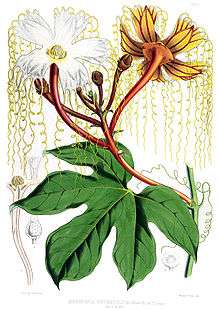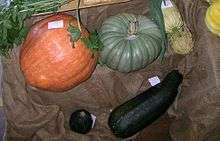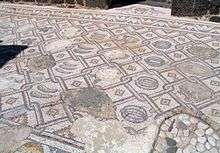Cucurbitaceae
| Cucurbitaceae | |
|---|---|
 | |
| Hodgsonia male plant | |
| Scientific classification | |
| Kingdom: | Plantae |
| Clade: | Angiosperms |
| Clade: | Eudicots |
| Clade: | Rosids |
| Order: | Cucurbitales |
| Family: | Cucurbitaceae Juss.[1] |
| Type genus | |
| Cucurbita | |
| Tribes and genera | |
|
See text. | |
The Cucurbitaceae (/kjuːˌkɜːrbɪˈteɪsii/), also called cucurbits and the gourd family, are a plant family consisting of about 965 species in around 95 genera,[2] the most important of which are:
- Cucurbita – squash, pumpkin, zucchini, some gourds
- Lagenaria – calabash, and others that are inedible
- Citrullus – watermelon (C. lanatus, C. colocynthis) and others
- Cucumis – cucumber (C. sativus), various melons
- Luffa – the common name is also luffa, sometimes spelled loofah (when fully ripened, two species of this fibrous fruit are the source of the loofah scrubbing sponge)
The plants in this family are grown around the tropics and in temperate areas, where those with edible fruits were among the earliest cultivated plants in both the Old and New Worlds. The Cucurbitaceae family ranks among the highest of plant families for number and percentage of species used as human food.[3]
The Cucurbitaceae consist of 98 proposed genera with 975 species,[4] mainly in regions tropical and subtropical. All species are sensitive to frost. Most of the plants in this family are annual vines, but some are woody lianas, thorny shrubs, or trees (Dendrosicyos). Many species have large, yellow or white flowers. The stems are hairy and pentangular. Tendrils are present at 90° to the leaf petioles at nodes. Leaves are exstipulate alternate simple palmately lobed or palmately compound. The flowers are unisexual, with male and female flowers on different plants (dioecious) or on the same plant (monoecious). The female flowers have inferior ovaries. The fruit is often a kind of modified berry called a pepo.
Fossil history
One of the oldest fossil cucurbits so far is †Cucurbitaciphyllum lobatum from the Paleocene epoch, found at Shirley Canal, Montana. It was described for the first time in 1924 by the paleobotanist Frank Hall Knowlton. The fossil leaf is palmate, trilobed with rounded lobal sinuses and an entire or serrate margin. It has a leaf pattern similar to the members of the genera Kedrostis, Melothria and Zehneria.[5]
Classification
Tribal classification

.jpg)
_Madrid_Botanico.jpg)
The most recent classification of Cucurbitaceae delineates 15 tribes:[6][7]
- Tribe Gomphogyneae Benth. & Hook. f. 1867
- Alsomitra (Blume) Spach 1838 (1 sp.)
- Bayabusua (1 sp.)
- Gomphogyne Griff. 1845 (2 spp.)
- Gynostemma Blume 1825 (10 spp.)
- Hemsleya Cogn. ex F.B. Forbes & Hemsl. 1888 (30 spp.)
- Neoalsomitra Hutch. 1942 (12 spp.)
- Tribe Triceratieae A. Rich. 1845
- Anisosperma Silva Manso 1836 (1 sp.)
- Cyclantheropsis Harms 1896 (3 spp.)
- Fevillea L. 1753 (8 spp.)
- Pteropepon (Cogn.) Cogn. 1916 (5 spp.)
- Sicydium Schltdl. 1832 (7 spp.)
- Tribe Zanonieae Benth. & Hook. f. 1867
- Gerrardanthus Harvey in Hook. f. 1867 (3–5 spp.)
- Siolmatra Baill. 1885 (1 sp.)
- Xerosicyos Humbert 1939 (5 spp.)
- Zanonia L. 1753 (1 sp.)
- Tribe Actinostemmateae H. Schaef. & S.S. Renner 2011
- Actinostemma Griff. 1841 (3 spp.)
- Tribe Indofevilleeae H. Schaef. & S.S. Renner 2011
- Indofevillea Chatterjee 1946 (1 sp.)
- Tribe Thladiantheae H. Schaef. & S.S. Renner 2011
- Baijiania A.M. Lu & J.Q. Li 1993 (30 spp.)
- Thladiantha Bunge 1833 (5 spp.)
- Tribe Siraitieae H. Schaef. & S.S. Renner 2011
- Siraitia Merr. 1934 (3–4 spp.)
- Tribe Momordiceae H. Schaef. & S.S. Renner 2011
- Momordica L. 1753 (60 spp.)
- Tribe Joliffieae Schrad. 1838
- Ampelosicyos Thouars 1808 (5 spp.)
- Cogniauxia Baill. 1844 (2 spp.)
- Telfairia Hook. 1827 (3 spp.)
- Tribe Bryonieae Dumort. 1827
- Tribe Schizopeponeae C. Jeffrey 1964
- Herpetospermum Wall. ex Hook. f. 1867 (3 spp.)
- Schizopepon Maxim. 1859 (6–8 spp.)
- Tribe Sicyoeae Schrad. 1838
- Cyclanthera Schrad. 1831 (40 spp.)
- Echinocystis Torr. & A. Gray 1840 (1 sp.)
- Echinopepon Naudin 1866 (20 spp., including Brandegea Cogn. 1890)
- Frantzia Pittier 1910 (5 spp.)
- Hanburia Seem. 1858 (7 spp.)
- Hodgsonia Hook. f. & Thomson 1854 (2 spp.)
- Linnaeosicyos H. Schaef. & Kocyan 2008 (1 sp.)
- Luffa Mill. 1754 (5–7 spp.)
- Marah Kellogg 1854 (7 spp.)
- Nothoalsomitra Hutch. 1942 (1 sp.)
- Sicyos L. 1753 (75 spp., including Sechium P. Browne 1756)
- Trichosanthes L. 1753 (≤100 spp.)
- Tribe Coniandreae Endl. 1839
- Apodanthera Arn. 1841 (16 spp.)
- Bambekea Cogn. 1916 (1 sp.)
- Ceratosanthes Adans. 1763 (4 spp.)
- Corallocarpus Welw. ex Benth. & Hook. f. 1867 (17 spp.)
- Cucurbitella Walp. 1846 (1 sp.)
- Dendrosicyos Balf. f. 1882 (1 sp.)
- Doyerea Grosourdy 1864 (1 sp.)
- Eureiandra Hook. f. 1867 (8 spp.)
- Gurania (Schltdl.) Cogn. 1875 (37 spp.)
- Halosicyos Mart. Crov 1947 (1 sp.)
- Helmontia Cogn. 1875 (2–4 spp.)
- Ibervillea Greene 1895 (9–10 spp.)
- Kedrostis Medik. 1791 (28 spp.)
- Melotrianthus M. Crovetto 1954 (1–3 spp.)
- Psiguria Neck. ex Arn. 1841 (6–12 spp.)
- Seyrigia Keraudren 1960 [1961] (6 spp.)
- Trochomeriopsis Cogn. 1881 (1 sp.)
- Tumamoca Rose 1912 (2 spp.)
- Wilbrandia Silva Manso 1836 (5 spp.)
- Tribe Benincaseae Ser. 1825
- Acanthosicyos Welw. ex Hook. f. 1867 (1 sp.)
- Benincasa Savi 1818 (2 spp., including Praecitrullus Pangalo 1944)
- Borneosicyos (1–2 spp.)
- Cephalopentandra Chiov. 1929 (1 sp.)
- Citrullus Schrad. 1836 (4 spp.)
- Coccinia Wight & Arn. 1834 (30 spp.)
- Ctenolepis Hook. f. 1867 (3 spp.)
- Cucumis L. 1753 (65 spp.)
- Dactyliandra Hook. f. 1871 (2 spp.)
- Diplocyclos (Endl.) T. Post & Kuntze 1903 (4 spp.)
- Indomelothria (2 spp.)
- Khmeriosicyos (1 sp.)
- Lagenaria Ser. 1825 (6 spp.)
- Lemurosicyos Keraudren 1963 [1964] (1 sp.)
- Melothria L. 1753 (12 spp.)
- Muellerargia Cogn. 1881 (2 sp.)
- Papuasicyos (8 spp.)
- Peponium Engl. 1897 (20 spp.)
- Raphidiocystis Hook. f. 1867 (5 spp.)
- Ruthalicia C. Jeffrey 1962 (2 spp.)
- Scopellaria W.J. de Wilde & Duyfjes 2006 (2 spp.)
- Solena Lour. 1790 (3 spp.)
- Trochomeria Hook. f. 1867 (8 spp.)
- Zehneria Endl. 1833 (ca. 60 spp.)
- Tribe Cucurbiteae Ser. 1825
- Abobra Naudin 1862 (1 sp.)
- Calycophysum H. Karst. & Triana 1854 [1855] (5 spp.)
- Cayaponia Silva Manso 1836 (50–59 spp., including Selysia Cogn. 1881)
- Cionosicys Griseb. 1864 [1860] (4–5 spp.)
- Cucurbita L. 1753 (15 spp.)
- Penelopeia Urb. 1921 (2 spp.)
- Peponopsis Naudin 1859 (1 sp.)
- Polyclathra Bertol. 1840 (6 spp.)
- Schizocarpum Schrad. 1830 (11 spp.)
- Sicana Naudin 1862 (4 spp.)
- Tecunumania Standl. & Steyerm. 1944 (1 sp.)
Alphabetical list of genera
Abobra, Acanthosicyos, Actinostemma, Alsomitra, Ampelosicyos, Anisosperma, Apodanthera, Austrobryonia, Baijiania, Bambekea, Bayabusua, Benincasa, Borneosicyos, Bryonia, Calycophysum, Cayaponia, Cephalopentandra, Ceratosanthes, Cionosicys, Citrullus, Coccinia, Cogniauxia, Corallocarpus, Ctenolepis, Cucumis, Cucurbita, Cucurbitella, Cyclanthera, Cyclantheropsis, Dactyliandra, Dendrosicyos, Diplocyclos, Doyerea, Ecballium, Echinocystis, Echinopepon, Eureiandra, Fevillea, Frantzia, Gerrardanthus, Gomphogyne, Gurania, Gynostemma, Halosicyos, Hanburia, Helmontia, Hemsleya, Herpetospermum, Hodgsonia, Ibervillea, Indofevillea, Indomelothria, Kedrostis, Khmeriosicyos, Lagenaria, Lemurosicyos, Linnaeosicyos, Luffa, Marah, Melothria, Melotrianthus, Momordica, Muellerargia, Neoalsomitra, Nothoalsomitra, Papuasicyos, Penelopeia, Peponium, Peponopsis, Polyclathra, Psiguria, Pteropepon, Raphidiocystis, Ruthalicia, Schizocarpum, Schizopepon, Scopellaria, Seyrigia, Sicana, Sicydium, Sicyos, Siolmatra, Siraitia, Solena, Tecunumania, Telfairia, Thladiantha, Trichosanthes, Trochomeria, Trochomeriopsis, Tumamoca, Wilbrandia, Xerosicyos, Zanonia, Zehneria.
Systematics
Modern molecular phylogenetics suggest the following relationships:[6][8][9][10][11][12]
|
| |||||||||||||||||||||||||||||||||||||||||||||||||||||||||||||||||||||||||||||||||||||||||||||||||||||||||||||||||||||||||||||||||||||||||||||||||||||||||||||||||||||||||||||||||||||||||||||||||||||||||||||||||||||||||||||||||||||||||||||||||||||||||||||||||||||||||||||||||||||||||||||||||||||||||||||||||||||||||||||||||||||||||||||||||||||||||||||||||||||||||||||||||||||||||||||||||||||||||||||||||||||||||||||||||||||||||||||||||||||||||||||||||||||||||||||||||||||||||||||||||||||||||||||||||||||||||||||||||||||||||||||||||||||||||||||||||||
Images of cucurbits in Byzantine mosaics from Israel

Six cucurbit crops are represented in 23 Byzantine-era mosaics from Israel, these being round melons (Cucumis melo), watermelons (Citrullus lanatus), sponge gourds (Luffa aegyptiaca), snake melons (faqqous, Cucumis melo flexuosus group), adzhur melons (C. melo adzhur group), and bottle gourds (Lagenaria siceraria). Cucurbits are represented in 23 of the 134 mosaics containing images of crop plants, a surprisingly high frequency of 17%. Several of the cucurbit images have not been found elsewhere, suggesting a diverse and highly developed local horticulture of cucurbits in Israel during the Byzantine era. Representations of mature sponge gourds are found in widespread localities, suggestive of the high value accorded to cleanliness and hygiene.[13]
Etymology and pronunciation
The name Cucurbitaceae comes to international scientific vocabulary from New Latin, from Cucurbita, the type genus, + -aceae,[14] a standardized suffix for plant family names in modern taxonomy. The genus name comes from the Classical Latin word cucurbita, "gourd".
References
- ↑ Angiosperm Phylogeny Group (2009). "An update of the Angiosperm Phylogeny Group classification for the orders and families of flowering plants: APG III". Botanical Journal of the Linnean Society. 161 (2): 105–121. doi:10.1111/j.1095-8339.2009.00996.x.
- ↑ Christenhusz, M. J. M. & Byng, J. W. (2016). "The number of known plants species in the world and its annual increase". Phytotaxa. 261 (3): 201–217. doi:10.11646/phytotaxa.261.3.1.
- ↑ "Cucurbits". Purdue University. Retrieved August 26, 2013.
- ↑ "Angiosperm Phylogeny Website". mobot.org.
- ↑ Revisions to Roland Brown's North American Paleocene Flora by Steven R. Manchester at Florida Museum of Natural History, University of Florida, Gainesville, Florida, USA. Published in Acta Musei Nationalis Pragae, Series B - Historia Naturalis, vol. 70, 2014, no. 3-4, pp. 153-210.
- 1 2 Schaefer H, Renner SS (2011). "Phylogenetic relationships in the order Cucurbitales and a new classification of the gourd family (Cucurbitaceae)" (PDF). Taxon. 60 (1): 122–138. JSTOR 41059827. Archived from the original on 27 February 2017.
- ↑ Schaefer H, Kocyan A, Renner SS (2007). "Phylogenetics of Cucumis (Cucurbitaceae): Cucumber (C. sativus) belongs in an Asian/Australian clade far from melon (C. melo)". BMC Evolutionary Biology. 7: 58–69. doi:10.1186/1471-2148-7-58. PMC 3225884. PMID 17425784.
- ↑ Zhang L-B, Simmons MP, Kocyan A, Renner SS (2006). "Phylogeny of the Cucurbitales based on DNA sequences of nine loci from three genomes: Implications for morphological and sexual system evolution" (PDF). Molecular Phylogenetics and Evolution. 39 (2): 305–322. doi:10.1016/j.ympev.2005.10.002. PMID 16293423. Archived from the original on 27 February 2017.
- ↑ Schaefer H, Heibl C, Renner SS (2009). "Gourds afloat: A dated phylogeny reveals an Asian origin of the gourd family (Cucurbitaceae) and numerous oversea dispersal events" (PDF). Proc Royal Soc B. 276 (1658): 843–851. doi:10.1098/rspb.2008.1447. PMC 2664369. PMID 19033142. Archived from the original on 27 February 2017.
- ↑ de Boer HJ, Schaefer H, Thulin M, Renner SS (2012). "Evolution and loss of long-fringed petals: A case study using a dated phylogeny of the snake gourds, Trichosanthes (Cucurbitaceae)". BMC Evolutionary Biology. 12: 108. doi:10.1186/1471-2148-12-108. PMC 3502538. PMID 22759528.
- ↑ Belgrano MJ (2012). Estudio sistemático y biogeográfico del género Apodanthera Arn. (Cucurbitaceae) [Systematic and biogeographic study of the genus Apodanthera Arn. (Cucurbitaceae)] (Ph.D.). Universidad Nacional de La Plata.
- ↑ Renner SS, Schaefer H (2016). "Phylogeny and evolution of the Cucurbitaceae". In Grumet R, Katzir N, Garcia-Mas J. Genetics and Genomics of Cucurbitaceae. Plant Genetics and Genomics: Crops and Models. 20. New York, NY: Springer International Publishing. pp. 1–11. doi:10.1007/7397_2016_14. ISBN 978-3-319-49330-5.
- ↑ Avital, Anat; Paris, Harry S. (2014-08-01). "Cucurbits depicted in Byzantine mosaics from Israel, 350–600 ce". Annals of Botany. 114 (2): 203–222. doi:10.1093/aob/mcu106. ISSN 0305-7364. PMC 4111391. PMID 24948671.
- ↑ Merriam-Webster, Merriam-Webster's Unabridged Dictionary, Merriam-Webster.
Further reading
- Bates D, Robinson R, Jeffrey C, eds. (1990). Biology and Utilization of the Cucurbitaceae. Cornell University Press. ISBN 978-0-8014-1670-5.
- Jeffrey C. (2005). "A new system of Cucurbitaceae". Bot. Zhurn. 90: 332–335.
External links
| Wikimedia Commons has media related to Cucurbitaceae. |
| Wikispecies has information related to Cucurbitaceae |